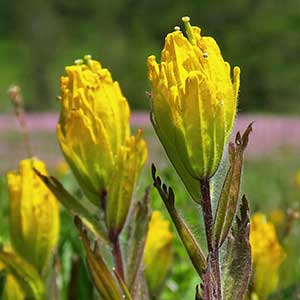Castilleja levisecta
Castilleja brevistyla
golden Indian paintbrush, golden paintbrush
short-style owl's-clover, shortstyle Indian paintbrush
few to many, erect, ± decumbent or creeping at base, unbranched, sometimes branched, hairs spreading, medium length and long, soft, mixed with short stipitate-glandular ones.
solitary or few, erect, unbranched, sometimes branched, hairs spreading, short and long, soft and stiff, eglandular.
green to purple or brown-tinged, linear-lanceolate proximally, oblong-ovate or -obovate distally, 0.8–5.2 cm, not fleshy, margins plane, distalmost sometimes ± wavy, involute, 3–7(–11)-lobed, apex obtuse;
lobes erect to ascending, linear to linear-spatulate, very short, toothlike, usually arising from distal 1/3 of blade, apex rounded.
green to purplish, linear to linear-lanceolate, (0.8–)2–6(–8.7) cm, not fleshy, margins plane, flat, 3–5-lobed, apex acuminate;
lobes ascending, linear to narrowly lanceolate, long, apex acuminate to rounded.
2.5–25 × 1–4 cm;
bracts bright yellow throughout, or proximally greenish, distally bright yellow, sometimes deep yellow-orange, especially with age, oblong, elliptic, or obtuse to ovate, (0–)5–9(–13)-lobed, sometimes wavy-margined;
lobes erect to ascending, oblong, short to medium length, arising above mid length, central lobe apex rounded, lateral ones rounded to acute.
5–25 (longer in fruit) × 1–2 cm;
bracts proximally greenish to dull reddish brown, distally pink, lavender, magenta, purple-red, or white on apices, narrowly lanceolate, (3–)5-lobed;
lobes ascending, linear to narrowly lanceolate with slightly widened apices, medium length to long, arising near or below mid length, apex acute.
straight or slightly curved, 17–28 mm;
tube 12–15 mm;
beak exserted, adaxially green or greenish yellow, 6–8 mm;
abaxial lip yellow or greenish, reduced, not inflated, 2–3 mm, 25–33(–50)% as long as beak;
teeth ascending to erect, yellow, 0.5–1.5 mm.
straight, 15–30 mm;
tube 14–23 mm, not expanded distally, majority of it exserted from calyx;
beak straight, adaxially white or pink (drying purple), 4–6 mm, pubescent;
abaxial lip ± inconspicuous, exserted, pouches 3, 2 mm wide, 1–1.5 mm deep, 3–5 mm, 50–70% as long as beak, white, yellow, or pink with large deep purple, red, or brown spot on each pouch at or extending below middle;
teeth erect, white, yellow, or pink, 1–1.5 mm.
distally yellow, 13–22 mm;
abaxial and adaxial clefts 4–9.5 mm, 30–40% of calyx length, deeper than laterals, lateral 2.5–4.5 mm, ca. 25% of calyx length;
lobes linear to narrowly oblong or narrowly lanceolate, apex obtuse, sometimes rounded to acute.
colored as bracts, sometimes proximally yellow, 15–20 mm;
abaxial and adaxial clefts 7–9.5 mm, abaxial ca. 33% of calyx length, adaxial ca. 66% of calyx length, deeper than laterals, lateral 3–5.5 mm, 33% of calyx length;
lobes ± linear, slender, all 4 similar, apex acute.
glabrous.
= 24.
= 48.
Castilleja levisecta
Castilleja brevistyla
Castilleja levisecta is listed as threatened in the United States and endangered in Canada, where it is extremely rare. Most of its grassland habitat has been altered by development in the Puget Trough, and there are historical stations in the metro areas of what are now Victoria, Portland, and Seattle. For several decades, C. levisecta was considered extirpated from Oregon. However, recent reintroduction programs in Oregon and Washington have been very successful at reestablishing this species at several sites in the Willamette Valley. The bright yellow inflorescences often gradually age to a golden yellow color, unique in the genus.
Castilleja levisecta is in the Center for Plant Conservation’s National Collection of Endangered Plants.
(Discussion copyrighted by Flora of North America; reprinted with permission.)
Castilleja brevistyla is endemic to the foothills of the southern Sierra Nevada and the southern reaches of the Inner South Coast Ranges, in Kern and adjacent counties. It often grows with other annuals, including C. attenuata, C. densiflora, and C. exserta. The similar C. attenuata has three-lobed bracts and leaves, while C. brevistyla has mostly five-lobed parts, and also differs in corolla structure and spotting. Hybrids between C. brevistyla and C. exserta are known from Kern County.
(Discussion copyrighted by Flora of North America; reprinted with permission.)


